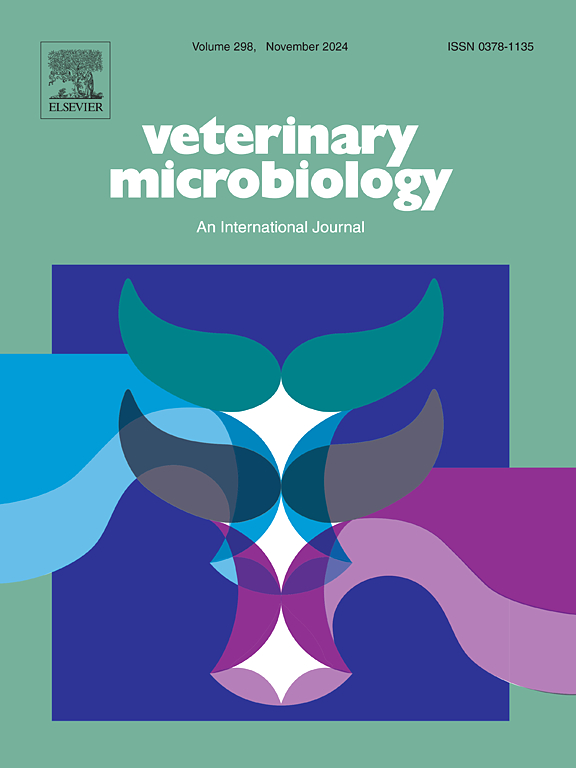Identification of host factors affecting Chicken Infectious Anemia Virus infection and pathogenicity through RNA-seq and LC-MS
IF 2.4
2区 农林科学
Q3 MICROBIOLOGY
引用次数: 0
Abstract
Chicken Infectious Anemia Virus (CIAV) infection causes severe anemia, hematopoietic disorders, and immunosuppression in poultry. However, the mechanisms underlying its pathogenicity remain poorly understood. In this study, RNA sequencing (RNA-seq) was employed to investigate the transcriptional response of MSB1 cells to CIAV infection at 12, 24, and 48 hours post-infection. The results revealed differential gene expression associated with immune response, inflammatory response, apoptosis, and metabolic pathways. Several immune-related factors, including IL18, TRAF1, MYD88, IRF2, and CD28, were found to be downregulated. VP1, the capsid protein of CIAV, plays a significant role in viral pathogenicity. To explore how VP1 affects CIAV replication and pathogenicity, co-immunoprecipitation (Co-IP) was used to identify host proteins interacting with VP1. Liquid chromatography-mass spectrometry (LC-MS) analysis revealed that VP1 interacts with a range of host proteins involved in metabolic pathways, the PI3K-AKT signaling pathway, and ribosomal functions. Based on RNA-seq and LC-MS findings, ANXA6 and HSP90aa1 were identified as key interacting partners, which co-localize in the cytoplasm of infected cells. Both proteins are involved in immune responses and metabolic regulation and were found to be downregulated in CIAV-infected cells. Notably, overexpression of ANXA6 or HSP90aa1 inhibited CIAV infection during the early stages of the viral lifecycle. These findings enhance our understanding of the host factors influencing CIAV infection and provide new insights into potential therapeutic targets for managing CIAV-induced diseases.
通过 RNA-seq 和 LC-MS 鉴定影响鸡传染性贫血病毒感染和致病性的宿主因素
鸡传染性贫血病毒(CIAV)感染导致家禽严重贫血、造血功能紊乱和免疫抑制。然而,其致病机制仍然知之甚少。在本研究中,采用RNA测序(RNA-seq)方法研究了感染后12、24和48 小时MSB1细胞对CIAV感染的转录反应。结果显示不同的基因表达与免疫反应、炎症反应、细胞凋亡和代谢途径相关。一些免疫相关因子,包括IL18、TRAF1、MYD88、IRF2和CD28,被发现下调。VP1是CIAV的衣壳蛋白,在病毒致病性中起重要作用。为了探究VP1对CIAV复制和致病性的影响,采用共免疫沉淀(Co-IP)技术鉴定与VP1相互作用的宿主蛋白。液相色谱-质谱(LC-MS)分析显示,VP1与一系列参与代谢途径、PI3K-AKT信号通路和核糖体功能的宿主蛋白相互作用。基于RNA-seq和LC-MS结果,ANXA6和HSP90aa1被确定为关键的相互作用伙伴,它们在感染细胞的细胞质中共定位。这两种蛋白都参与免疫反应和代谢调节,在感染ciav的细胞中被发现下调。值得注意的是,在病毒生命周期的早期阶段,过表达ANXA6或HSP90aa1抑制了CIAV感染。这些发现增强了我们对影响CIAV感染的宿主因素的理解,并为管理CIAV诱导疾病的潜在治疗靶点提供了新的见解。
本文章由计算机程序翻译,如有差异,请以英文原文为准。
求助全文
约1分钟内获得全文
求助全文
来源期刊

Veterinary microbiology
农林科学-兽医学
CiteScore
5.90
自引率
6.10%
发文量
221
审稿时长
52 days
期刊介绍:
Veterinary Microbiology is concerned with microbial (bacterial, fungal, viral) diseases of domesticated vertebrate animals (livestock, companion animals, fur-bearing animals, game, poultry, fish) that supply food, other useful products or companionship. In addition, Microbial diseases of wild animals living in captivity, or as members of the feral fauna will also be considered if the infections are of interest because of their interrelation with humans (zoonoses) and/or domestic animals. Studies of antimicrobial resistance are also included, provided that the results represent a substantial advance in knowledge. Authors are strongly encouraged to read - prior to submission - the Editorials (''Scope or cope'' and ''Scope or cope II'') published previously in the journal. The Editors reserve the right to suggest submission to another journal for those papers which they feel would be more appropriate for consideration by that journal.
Original research papers of high quality and novelty on aspects of control, host response, molecular biology, pathogenesis, prevention, and treatment of microbial diseases of animals are published. Papers dealing primarily with immunology, epidemiology, molecular biology and antiviral or microbial agents will only be considered if they demonstrate a clear impact on a disease. Papers focusing solely on diagnostic techniques (such as another PCR protocol or ELISA) will not be published - focus should be on a microorganism and not on a particular technique. Papers only reporting microbial sequences, transcriptomics data, or proteomics data will not be considered unless the results represent a substantial advance in knowledge.
Drug trial papers will be considered if they have general application or significance. Papers on the identification of microorganisms will also be considered, but detailed taxonomic studies do not fall within the scope of the journal. Case reports will not be published, unless they have general application or contain novel aspects. Papers of geographically limited interest, which repeat what had been established elsewhere will not be considered. The readership of the journal is global.
 求助内容:
求助内容: 应助结果提醒方式:
应助结果提醒方式:


